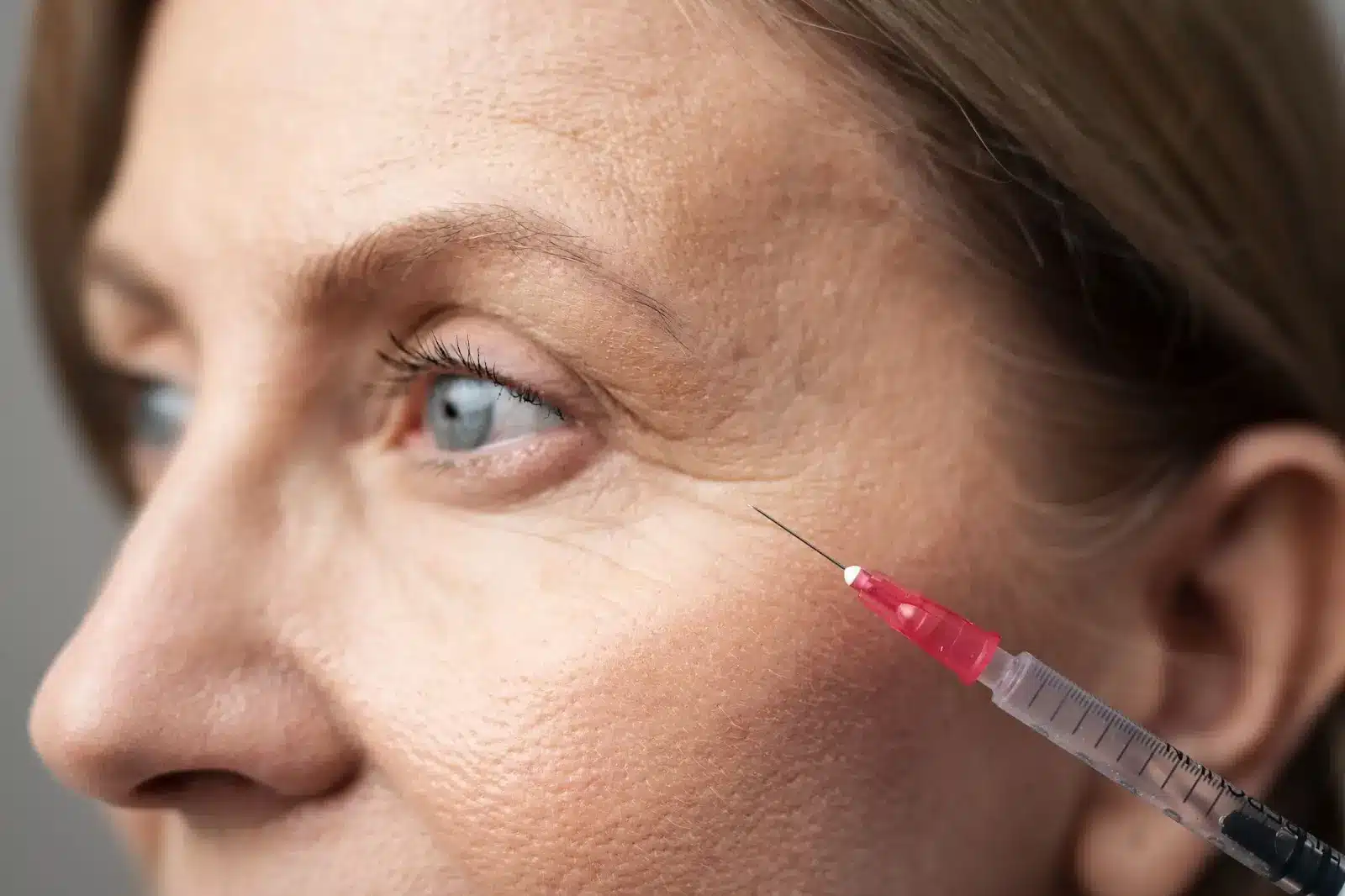
Intravitreal anti-VEGF injections have revolutionized the care of retinal diseases, providing millions of patients with the opportunity to preserve vision that would otherwise be lost. Their use has skyrocketed across the globe. In Portugal, for example, the number of annual treatments nearly doubled between 2013 and 2018, highlighting just how central these injections have become in everyday eye care.
Two of the most widely used options are Eylea (aflibercept) and Vabysmo (faricimab-svoa). While both are designed to treat conditions like wet age-related macular degeneration (nAMD) and diabetic macular edema (DME), they work in slightly different ways. Eylea blocks VEGF-A and PlGF, while Vabysmo uniquely targets VEGF-A and Ang-2, offering a dual approach that may influence treatment outcomes and dosing schedules.
This article provides a clear, side-by-side comparison of Vabysmo vs Eylea, covering their mechanisms, dosing intervals, benefits, and safety profiles. The goal is to help patients and clinicians alike better understand the strengths of each option and how they fit into real-world treatment decisions.
Key Takeaways
- Eylea (aflibercept) blocks VEGF-A, VEGF-B, and PlGF, while Vabysmo (faricimab) targets VEGF-A and Ang-2, offering a dual-pathway approach that may improve vascular stability.
- Large parallel-group trials (TENAYA, LUCERNE, YOSEMITE, RHINE) showed similar vision outcomes for both drugs, confirming Vabysmo is non-inferior to Eylea.
- Durability differs: Eylea is usually dosed every 8 weeks, while many Vabysmo patients can extend to 12–16 weeks. Not all patients reach the maximum interval, but longer spacing can reduce clinic visits and treatment burden.
- In some analyses, Vabysmo achieved greater fluid reduction, though results were not consistent across all studies. Both drugs remain highly effective in preserving sight.
- Vabysmo side effects are comparable to those of Eylea, including mild eye pain, redness, and blurred vision, as well as very rare complications such as endophthalmitis or retinal detachment.
- Safety history matters: Eylea has over a decade of post-marketing experience, while Vabysmo now has more than 3 years of real-world use, showing a reassuring safety profile.
- The best choice depends on individual needs: Eylea offers long-established reliability, while Vabysmo provides innovation with its dual inhibition and potential for fewer injections.
About: Doctor Medica is your trusted supplier of top-quality dermal fillers, viscosupplements, and more for your medical practice. We offer genuine products from leading brands at the lowest prices in the market. If you’re looking to order Vabysmo online for your practice, contact Doctor Medica today.
Mechanism of Action: Vabysmo Dual Inhibition vs Eylea VEGF Blockade

Eylea (aflibercept) works by binding and blocking multiple growth factors that drive abnormal retinal blood vessel growth and leakage. It targets VEGF-A, VEGF-B, and PlGF, reducing swelling in the retina, stabilizing vision, and slowing disease progression. This single-pathway inhibition has been the cornerstone of treatment for conditions like age-related macular degeneration (AMD) and diabetic macular edema (DME) for more than a decade, helping millions preserve sight.
Vabysmo (faricimab-svoa), developed more recently, introduces a dual-pathway approach. Like Eylea, it blocks VEGF-A, but it also inhibits angiopoietin-2 (Ang-2). Ang-2 destabilizes blood vessels, making them prone to leakage and abnormal growth. By targeting both VEGF-A and Ang-2, Vabysmo helps reinforce vascular stability, offering broader protection against retinal damage.
This dual inhibition has been associated with improved durability in some patients, allowing them to go longer between injections compared to standard anti-VEGF therapy. However, not every patient reaches 16-week intervals—durability varies depending on disease activity and individual response. For clinicians, the choice between Eylea and Vabysmo reflects a decision between single-pathway inhibition and a dual-pathway strategy that may reduce treatment burden for selected patients.
Clinical Trial Outcomes Comparing Vabysmo and Eylea

Large parallel-group clinical trials, including TENAYA and LUCERNE for AMD, and YOSEMITE and RHINE for DME, evaluated Vabysmo against Eylea. While not actual head-to-head studies, these pivotal trials provide strong comparative insights.
Key Findings
- Both treatments produced similar improvements in best-corrected visual acuity (BCVA), showing that Vabysmo can match the gold-standard outcomes achieved with Eylea.
- A higher proportion of Vabysmo patients were able to extend dosing intervals to 12–16 weeks, reducing the frequency of injections. That said, not all patients achieved the longest interval, and extension success depended on baseline disease activity.
- In some analyses, Vabysmo achieved greater reductions in central subfield thickness (CST), suggesting improved fluid control for certain patients, though results were not uniformly statistically significant across all studies.
- A review of resistant cases noted that Vabysmo provided anatomical improvements in eyes unresponsive to prior therapies (such as bevacizumab or dexamethasone implants), even if visual gains were modest. This suggests a role for Vabysmo in difficult-to-treat populations, including those with subretinal neovascular membranes (SRNVM) seen in advanced AMD.
Taken together, these outcomes demonstrate that Vabysmo matches Eylea in vision preservation while offering the potential advantage of longer dosing intervals and improved fluid resolution in select patients. For many, this translates to fewer injections and fewer clinic visits while maintaining stable vision.
Dosing Frequency and Durability: Vabysmo vs Eylea
One of the most practical differences between the two drugs is dosing frequency, which directly impacts patient quality of life, convenience, and adherence.
| Treatment | Typical Dosing Schedule | Durability | Impact on Patients |
| Eylea | Every 8 weeks after loading doses | Some patients extend beyond 8 weeks, but many remain bi-monthly | More frequent clinic visits and needle-related stress |
| Vabysmo | Every 12–16 weeks after loading doses | Extended durability with longer control of disease | Fewer injections, reduced anxiety, lighter treatment burden |
While both treatments remain highly effective, Vabysmo’s potential for longer durability offers greater flexibility in long-term care. For patients who qualify, this can mean fewer injections per year, less disruption to daily life, and reduced clinic burden. Still, not every patient will reach the maximum extension interval, so personalized treatment planning remains essential.
Safety Profiles and Side Effects: Vabysmo vs Eylea
When choosing between therapies, safety is just as important as efficacy. Since both are delivered as intravitreal injections, they share the risks linked to the injection procedure itself. These include conjunctival hemorrhage, eye pain, temporary blurred vision, and transient intraocular pressure elevations.
Common Side Effects for Both Treatments
- Conjunctival hemorrhage (small blood spots on the eye)
- Mild to moderate eye pain or irritation shortly after injection
- Temporary blurred vision as the eye adjusts post-injection
- Transient increases in intraocular pressure
Serious but Rare Risks Associated with Both
- Endophthalmitis (a potentially sight-threatening eye infection)
- Retinal detachment, requiring urgent treatment
- Severe vision loss linked to rare complications of injection therapy
When specifically considering Vabysmo side effects, clinical trials and early post-marketing data show a safety profile comparable to Eylea. One distinction is history: Eylea has more than 10 years of real-world safety data, while Vabysmo now has over 3 years of post-marketing experience in some regions, with outcomes remaining consistent with trial findings.
For patients and physicians, this means weighing the reassurance of Eylea’s longer record against the innovative dual inhibition mechanism of Vabysmo. In both cases, regular monitoring and follow-up visits are crucial to maintaining safety.
Conclusion
The choice between Vabysmo and Eylea comes down to patient needs, disease characteristics, and physician judgment. Eylea provides a long history of proven safety and effectiveness, while Vabysmo introduces innovation with its dual inhibition and potential for fewer injections. For patients who value reduced treatment burden, Vabysmo may be especially appealing, though not all individuals achieve the maximum extension interval.
Ultimately, the decision is best made through a personalized approach—one that balances efficacy, durability, safety, and lifestyle factors. With continued research and growing real-world evidence, both drugs remain central to the fight against sight-threatening retinal disease.
FAQs
1. What conditions are treated with Vabysmo and Eylea?
Both are approved for wet AMD and diabetic macular edema (DME). Eylea also has indications for retinal vein occlusion, while Vabysmo’s approvals continue to expand internationally.
2. Is Vabysmo more effective than Eylea?
Clinical trials show Vabysmo is non-inferior to Eylea for vision outcomes. Its dual inhibition offers added potential benefits in fluid control and dosing durability, but overall effectiveness remains comparable.
3. How often do patients need injections?
Eylea is usually given every 8 weeks after initial loading doses. Many patients on Vabysmo can extend dosing to 12–16 weeks, though success varies by individual.
4. Which treatment is safer, Vabysmo or Eylea?
Both share a similar safety profile. Eylea has a longer clinical track record, while Vabysmo now has several years of consistent post-marketing safety data. Patients should discuss risks and preferences with their ophthalmologist.
References
Rocha JV, Marques AP, Macedo AF, et al. Trends, geographical variation, and factors associated with the use of anti-VEGF intravitreal injections in Portugal (2013-2018): a retrospective analysis of administrative data. BMJ Open. 2022;12(4):e055478. Published 2022 Apr 6. doi:10.1136/bmjopen-2021-055478
Parikh R, Ross JS, Sangaralingham LR, Adelman RA, Shah ND, Barkmeier AJ. Trends of Anti-Vascular Endothelial Growth Factor Use in Ophthalmology Among Privately Insured and Medicare Advantage Patients. Ophthalmology. 2017;124(3):352-358. doi:10.1016/j.ophtha.2016.10.036
Related Articles
Joanna Carr
Botox For Incontinence: Treatment, Risks, And Side Effects
Interested in learning more about Botox For Incontinence Treatment, Risks, And Side Effects? Browse Doctor Medica's comprehensive archive of blog post...
Joanna Carr
How Dermal Fillers Help After Weight Loss
Have an interest in learning about How Dermal Fillers Help After Weight Loss? Browse Doctor Medica's extensive archive of blog postings.
Joanna Carr
Medical Spa Trends For 2023
Interested to learn more about Medical Spa Trends For This Year? Browse Doctor Medica's comprehensive listing of blog posts.


